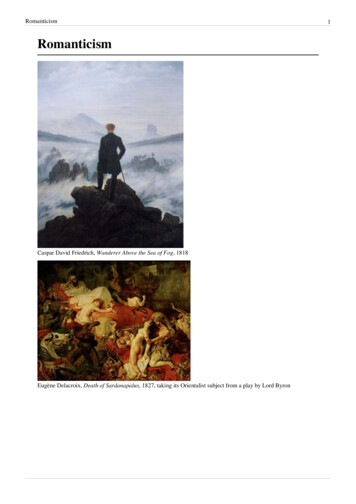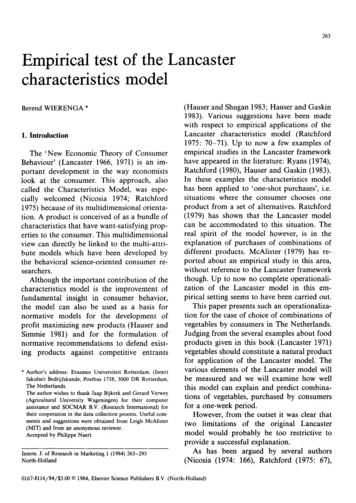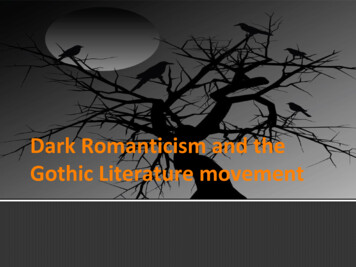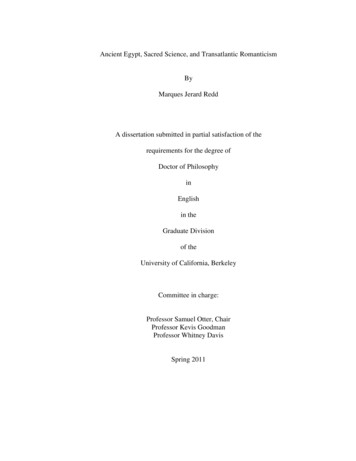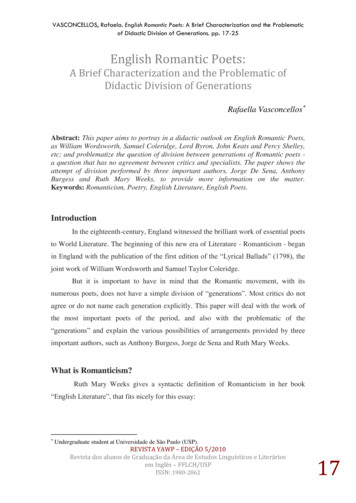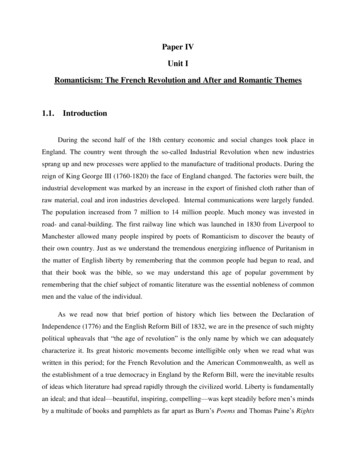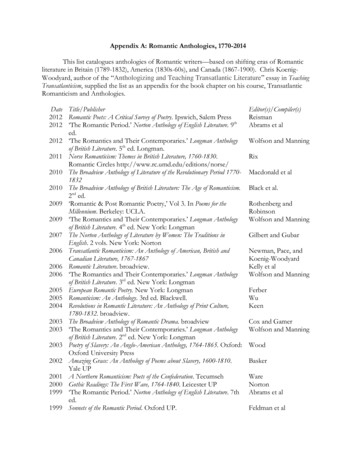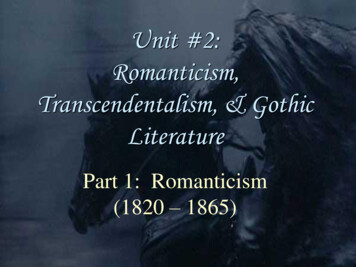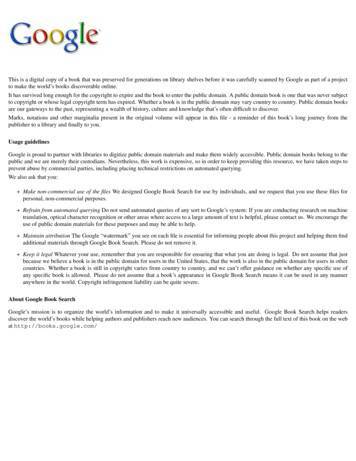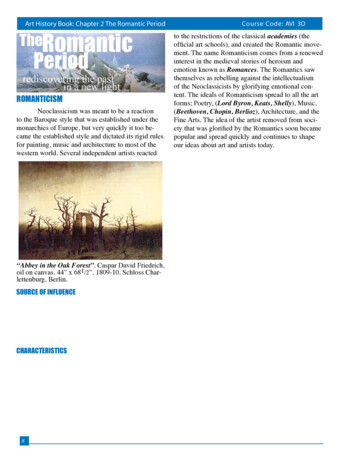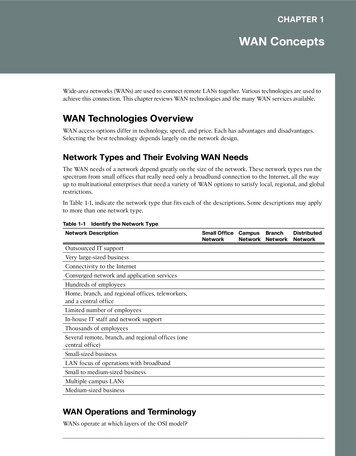
Transcription
Characteristics of Romanticism IntroductionRomanticism often considered as Romantic Age or Romantic Era was an artistic, literaryand intellectual movement of Europe. Many different dates are given for the rise of theRomantic Age but the publication of Lyrical Ballads by William Wordsworth and S. T. Coleridgein 1798 is taken as the beginning of the Romantic Era.Romanticism in literature concerned with the two bed – rock of emotions andimaginations. It introduces the readers to a world of strangeness and beauty as Pater considersit as “The addition of Strangeness in beauty.” He further said that –The desire of beauty being a fixed element in every artistic organization, it is theaddition of curiosity to the desire of beauty.Thus, the two most prominent elements of romanticism are curiosity and beauty.Romanticism also stands for freedom and liberty, and therefore it is “Literalism in Literature.” Rise of The RomanticismRomantic Movement dates its origin in 1798 with the publication of Lyrical Ballads byWilliam Wordsworth and S. T. Coleridge. This movement in literature was preceded andaccompanied by the change in literary styles. It was partly a reaction to the IndustrialRevolution and also the social and political norms of England as well as Europe. The rise of theRomanticism in English literature is somehow concerned with the Age of Enlightenment. Thesupreme Romantic Movement in English literature was the Renaissance. It had brought about atransformation not only in England but also in European life.
Characteristics of Romanticism[1] Contrast with Neo – ClassicismWhile talking about Neo – Classicism era, the Romantic era is totally opposed to it.There is a great contrast between Neo – Classicism and Romanticism. The main differencebetween neoclassicism and romanticism is that neoclassicism emphasized on objectivity, order,and restraint whereas romanticism emphasized on imagination and emotion. The main thing inthe poetry of Romanticism is the break from the thralldom of rules and regulations. W. J. Longmarks –The Romantic Movement was marked by a strong reaction and protests againstthe bondage of rule and custom which in literature, generally tend to fetter thefree human spirit.[2] Love for FreedomIn Romantic Poetry, the emphasis was laid on liberty and freedom of the individual.Romantic poets were rebels against tyranny and brutality exercised by tyrants and despots overhumans crushed by poverty and smashed by inhuman laws. English romanticism was anexpression of the desire for freedom from the restraining forces of reason and the assertion ofthe rights of feeling and imagination. Thus, Freedom is the breath in which the Romantic poetsbreathed freely.[3] SupernaturalismSupernaturalism is another outstanding quality of Romantic Poetry. Poets like Coleridgeand Scott gave a sense of wonder and mystery to poetry. It was this supernaturalism that gavethe atmosphere of wonder and mystery to the Romantic Poetry. Most of the romantic poets
used supernatural elements in their poetry. Samuel Taylor Coleridge is the leading romanticpoet in this regard, and "Kubla Khan" is full of supernatural elements.[4] SubjectivitySubjectivity is another important feature of the Romantic poets. Subjective poetry is akind of poetry in which the poet goes into himself and finds his inspiration from his ownexperiences, thoughts and feelings. Most of the Romantic poets are subject in this sense. Forexample, Keats’s “Ode to the Nightingale” is basically based on personal matter. Subjectivitybegan to have its full play in the poetry of this age as W. J. Long points out –The Romantic Movement was the expression of individual genius rather than ofthe established rules.[5] Variety of MoodsIn Romantic Poetry, we come across an endless variety. The poetry of this age is as varied as thecharacter and moods of different writers. A noted remark of W. J. Long said that –In the works of the best romanticists there is endless variety. To read them islike passing through a new village, meeting a score of different human types,and finding in each one something to Love or to remember.[6] Simplicity in StyleThe style of the Romantic Poets is varied but the stress was laid on simplicity. Instead ofan artificial mode of expression of classical poets, we have a natural diction and spontaneousway of expressing thoughts in Romantic Poetry. Romantic Poets believe in the simplicity in theirstyle. They followed the simplicity in their works. They not followed the artificial mode of the
expression of classical Poetry. They have express thoughts in natural Diction and spontaneityway.[7] Emotion and ImaginationIn Romantic Poetry, reason and intellect were subdued and their place was taken byimaginations, emotions and passion. In the poetry of all the Romantic Poets, we findheightened emotional sensibilities and imaginative flights of genius bordering on heavenlyheights uncrossed by the poets of the previous age. Authors of The Romantic EraWilliam Wordsworth, born in 1770 and died in 1850, is considered as the father ofRomantic Movement. In fact, the Romanticism in English literature began with his publicationof Lyrical Ballads with co – author and his friend S. T. Coleridge. He was also the Poet Laureateof England from 1843 till his death in 1850.Samuel Taylor Coleridge, born in 1772 and died in 1834, was another great poet ofRomantic Era. He was a good friend of William Wordsworth, and they two together publishedLyrical Ballads which marks the beginning of Romanticism. Coleridge contributed in RomanticMovement with his two best poems The Rime of Ancient, Christabel and Kubla Khan.John Keats, born in 1795 and died in 1821, was one of the prominent figures of thesecond generation of English Romantic poets. However, his reputation grew after his death. Hisfamous works are Ode to Nightingale and When I Have Fears.P. B. Shelley, born in 1792 and died in 1822, was an English poet and friend of JohnKeats who contributed in English Romanticism along with John Keats. His great works of thetime were Ode to The West Wind and A Defense of Poetry.
William Blake, born in 1757 and died in 1827, was highly influential figures in thehistory of Romantic era. His poetry often accompanied by fantastic imagery. Songs of Innocenceand Songs of Experience are the two great works of Blake. Works of The Romantic EraLyrical Ballads, The Rime of Ancient, Christabel, Kubla Khan, Ode to Nightingale, When IHave Fears, Ode to The West Wind, and Songs of Experience are some of the great works of theRomanticism of Literature. ConclusionThe Romantic period was one of major social, political and literary change in England.Romanticism in literature concerned with the two bed – rock of emotions and imaginations. Itintroduces the readers to a world of strangeness and beauty as Pater considers it as “Theaddition of Strangeness in beauty.” Thus, the two most prominent elements of romanticism arecuriosity and beauty. Romanticism also stands for freedom and liberty, and therefore it is“Literalism in Literature.”For more Study Materials visit: hlg7.weebly.com
The Oxford Movement IntroductionThe Oxford Movement was a movement of High Church members of the Church ofEngland. Its philosophy was known as Tractarianism after the publication of Tracts for TheTimes from 1833 to 1841. The Oxford Movement was deeply conservative in its attempts torevive the Catholic roots of the Angelical Church. The evolution of the Oxford Movement wasdisplayed in literature as well as in religion and political journals of the time. Many recentauthors claim that –The Oxford Movement prefigured issues that confront current religionsinstitutions and generated impassioned responses to the central conflicts ofnineteenth century thoughts.The Oxford Movement stood against too much insistence on reason and proof in religions, andsought to revive the faith of Roman Catholic Religion. Background of the Oxford MovementThe Oxford Movement began in 1833 by Angelical clergyman at the University of Oxfordto renew the Church of England. It ended in the year of 1841. The most prominent leaders ofthe movement were John Henry Newman (1801 – 1890), a clergyman; John Keble (1792 –1860), a clergyman and a poet; Edward Pusey (1800 – 1882), a clergyman and professor atOxford University. Cause of the Oxford MovementOxford of the 19th century was an impactful source of the movement. The OxfordMovement began when Newman’s colleague, John Keble gave a sermon called “NationalApostasy.” In it Keble called for a renewal of the English Church by reviving ancient Christian
practices. Also the interest in Christian origins caused to reconsider the relationship of theChurch of England with The Roman Catholic Church which later resulted as The OxfordMovement. Cardinal Newman and the Oxford MovementJohn Henry Newman also known as Cardinal Newman was born in 1801 and died in1890. He is one of the most influent leaders of the Oxford Movement. John Henry Newmanplayed an important part from the beginning to the end in the movement which changed theviews of the University of Oxford. He contributed twenty of the ninety “Tracts for The Times,”resigning his position in the Angelical Church.As the leader of the Oxford Movement, Newman repudiated Protestant individualism,and nineteenth century liberal Christianity. He upheld devotion, faith rituals, and dogmas inpreference to reason and proof. Newman wrote in defense that –After all man is not a reasoning animal, he is a seeing, feeling, acting animal. Lifeis not long enough for a religion of interference; we shall never have donebeginning, if we determine to began with proof.Cardinal Newman’s conversion to Roman Catholicism becomes an object of severecriticism and Charles Kingsley charged him of duplicity in changing from Protestantism toRoman Catholicism and propagating the Oxford Movement. Newman had the better of theargument, his defense is still read while Kingsley’s attack is forgotten. Literary Aspects of the Oxford MovementThe Oxford Movement was basically a religious movement, it had nothing to do withliterature as W. H. Hudson remarks –The Oxford Movement certainly belongs to the history of English religion moredefinitely than to the history of English Literature
However, the numerous writings had some contemporary styles and religion themes.Newman’s “The Idea of University” provides the basic principle concerning the site of theUniversity to the modern University. Another notable writing of Newman is “Apologia.”Newman employed a classical way of writing in the expression of his thoughts. His prose style ischaracterized by lucidity, transparency and balance. Newman, truly, knows how to make theuse of irony in an effective manner. Failure of the Oxford MovementThe Oxford Movement failed to have any influence on the psychological life of the day,and its impact on the growth of literature was not substantial. It could win the allegiance of afew poets and had some effect on the movement, but unfortunately it had not. It was failure atthe end. ConclusionAn Angelical priest Eugene R. Fairweather said –The Oxford Movement, for all its profound conservatism, seriously altered theaccepted patterns of the Angelical thought and practice.The Oxford Movement directed the attention of the people to the personal holiness. Itre – oriented the common views about apostolic authority. It also made the Church of Englandconserve of the onslaught of Liberalism. Thus the Oxford Movement was more than a passingripple on the surface of “The Sea of Faith.”For more Study Materials visit: hlg7.weebly.com
Dover Beach IntroductionMatthew Arnold was an English poet and cultural critic who was born in 1822 inMiddlesex, England. He has worked as an inspector of schools. Arnold was a great literary figurein Victorian Literature, and Dover Beach was the best among his many works.Dover Beach is a lyrical poem written by the English poet Matthew Arnold. It wasoriginally published in 1867. Dover Beach is one of the most popular and the mostrepresentative poems of Arnold. It is a short cry against the decay of Religious faith and itreveals Arnold’s outlook on Life. Theme of The PoemThe central theme of the poem that Arnold depicts is the loss of faith in religions andloss of cultures in societies, and the present world full of cruelty, uncertainty and violence. Thevery eye – catching line of the poem “The Sea of Faith” tells us about the central theme of thepoem. The line presents the loss of faith in religions. Technique of The PoemDover Beach consists of four stanzas, each containing a variable number of verses. Thereis no apparent rhyme scheme, but rather a free handling of the basic iambic pattern. Time and Place in The PoemMatthew Arnold wrote Dover Beach shortly after he visits Dover District Beach ofEngland in 1851. The poem was written in the year of 1851 just a few months after themarriage of Arnold. The town of Dover, where the poem took place, is much closer to Francethan any other cities of England.
The Sea of FaithDover Beach is a short cry on religious faith of people that was revealed in the line “TheSea of Faith.” It tells us the decaying of religious faith in the world and increasing hold of doubtsand fears among the minds of Victorian people. The poet says that the sea of faith was once fulland was dominating the world, but now it was losing faith and holds doubts and fears amongthe minds of the people which could be harmful to the peace of mankind. Criticism of LifeArnold points out –Only excellent poetry can offer criticism of life.Dover Beach is nothing but a criticism of life. It is the best example of Arnold’s conceptof criticism of life as it contains the expressions of his favorite theme the loss of faith of inmaterial world. The poem reveals Arnold’s outlook on life. Arnold says that –Only Love can make our Life purposeful and meaningful. Unrest and Anxietywould be disappeared by Love. ConclusionTo conclude, Dover Beach is a great poem with the criticism of life of modern world.Though the poem was not written in a particular rhyming scheme and looks complex to many,it is considered as one of the best works of Matthew Arnold. With many themes like losing faithin religious, love and the life of the people of modern world, the poem became the cornerstoneof Arnold’s success.For more Study Materials visit: hlg7.weebly.com
Ode to a Skylark IntroductionPercy Bysshe Shelley was one of the major English Romantic poets born in August 1792.He was the most important figure of Romanticism in English Literature. Shelley is perhaps bestknown for romantic poems such as Ode to the West Wind. Shelley did not see fame during hislifetime, but recognition of his achievements in poetry grew steadily following his death.To a Skylark is a poem composed in 1820 by P. B. Shelley and published in the sameyear. Shelley was inspired to write the poem when he heard sweet songs of the bird while hewas strolling with his friend Halesworth in Italy. The poem is addressed to a bird that singssongs of joy. Theme of The PoemThe theme of the poem is the true joy and positive feeling that derives from nature andgreatness rather than sorrow and negative emotions. Shelley says that –All human songs are sad, but the birds song is just pure joy.At last, the power of nature is another concentrating theme of To a Skylark. Technique of The PoemThe poem consists of twenty one stanzas made up of five lines each. The rhyme schemeof each stanza is ABABB. The first four lines of all the stanza are metered in Trochaic Trimeter,the fifth line in each stanza is made of iambic hexameter.
The Skylark in the PoemThe poem begins with the poet’s description of the bird Skylark with these followinglines:Hail to thee, blithe Spirit!Bird thou never wert,That from heaven, or near itPurest thy full hear,In profuse strains of unpremeditated, art.In the poem, poet addresses the bird as blithe spirit that sings songs of joy. The poet uses vividimages for the bird as the poet says that it flies higher and higher like a cloud of fire in the bluesky. The poet further said that no one knows what the skylark is, for it is unique; even therainbow clouds do not rain as brightly as the shower of melody that pours from the Skylark. The Power of NatureThe poem perhaps has the description of the power of nature somewhere andsomehow in the poem. In To a Skylark, the poet wants to know everything about skylark andnature. He wants to know the secrets and the power of nature, to know what birds feel whenthey sing. He is fascinated of the power of nature as well as of the Skylark. In the poem, Alongwith skylark, there is also a description of the power of nature and how the humans areconnected with it. Sadness of The PoetThroughout the poem, the poet feels sad. He feels things so deeply throughout thepoem and so establishes sadness.
The poet seems jealous of freedom of the Skylark, which travels where it wants,whereas poet has restriction and limitations in his life. Although the sadness of the poet is notthe important thing in the poem, it just mentioned in the poem when the poet talks abouthuman beings and their life. ConclusionThe Sonnet is represents of Wordsworth’s poetic genius throughout the poem. TheWorld Is Too Much with Us by William Wordsworth represents modern humanity's lost spiritualconnection with nature. The poem presents the conflict between nature and modern progress.For more Study Materials visit: hlg7.weebly.com
The World is Too Much with Us IntroductionThe World is Too Much with Us is a sonnet written by the English romantic poet WilliamWordsworth. William Wordsworth was born on 7 th April, 1770. His father was a law agent andrent collector. William Wordsworth began his career as a poet when he was yet a student. In1798, Wordsworth and Coleridge published The Lyrical Ballads. In 1839, he was honored byOxford University. In 1843, he became the poet Laureate. And in April 1850, he was died inEngland.The World is Too Much with Us is a poem that we often call like a sonnet. It waspublished in 1807. The World is Too Much with Us is written in the Petrarchan Sonnet form of14 iambic pentameter lines. The poem is concerned with poet’s love for nature. Theme of The PoemThere are many important themes in the poem such as morality, sadness, man and thenatural world and some others.Getting and spending, we lay waste our powers;Little we see in nature that is ours,We have given our hearts away, a sordid boon.In these lines, Wordsworth criticizes the materialism. Wordsworth feels that the blind belief inmaterialism prevents the people from realizing the true meaning and purpose of the Life.
Technique of The PoemThe World is Too Much with Us is a sonnet written in fourteen lines of iambicpentameter rhyming in the form of ABBA ABBA CDCDCD. The credit of such sonnet goes to theItalian poet Petrarch. Therefore, we may call The World Too Much with Us is a Petrarch Sonnet.The poem was written in the form of ABBA ABBA CDCDCD rhyming 14 lines of iambicpentameter lines. Symbolism and Imagery in The PoemThe Poem is a great example of use of the literary devices such as allegory, figure ofspeeches, symbolism, imagery and some others. However, symbolism and imagery are narratedperfectly in the poem by William Wordsworth.Wordsworth used symbolism in the poem to complaint that people nowadays areconsumed by the industrialism and they are no longer in interest with the beautiful nature. Alsothere are some imagery in the poem such as nature, senses, feelings, death and the use ofallusion; and all these were presented in the poem very well by Wordsworth. Love for NatureThis sonnet reveals Wordsworth’s love for the nature. In the poem, poet has given twobeautiful pictures of nature – one is that the picture of sea in moonlight and the other is thepicture of winds that sleep like flowers at night:The sea that bares her bosom to the moon;The winds that will be howling at all hours,And are up – gathered now like sleeping flowers.
Criticism of LifeThis sonnet is a great criticism of life of the people nowadays, living in the industrial age.William Wordsworth greatly concerned with nature and is a great critic of the industrialismopposed to the beauty of nature. Almost in every poetry of Wordsworth, we saw his love forthe nature.Wordsworth described the beauty of the nature throughout the poem. With thedescription of the beauty of nature, he has also criticizes human life of present industrialism.Wordsworth complaint that the lives of people nowadays are not much concerned with natureand their life is consumed by the industrial life. Thus, the poem is a criticism on the life ofIndustrialist people and is also the description of the beauty of nature. ConclusionThe Sonnet is represents of Wordsworth’s poetic genius throughout the poem. TheWorld Is Too Much with Us by William Wordsworth represents modern humanity's lost spiritualconnection with nature. The poem presents the conflict between nature and modern progress.For more Study Materials visit: hlg7.weebly.com
Hard Times as a Mirror of Victorian Society About AuthorCharles John Huffam Dickens, simply known as Charles Dickens and born in 1812, was anEnglish writer and social critic. He is regarded by many as the greatest novelist of the Victorianera. His works enjoyed unprecedented popularity during his lifetime, and by the 20th centurycritics and scholars had recognized him as a literary genius. His novels and short stories are stillwidely read today. IntroductionHard Times – For These Times is a great critical novel by Charles Dickens. It is commonlyknown as Hard Times. The novel was first published in 1854. It was Dickens’ tenth novel. Thebook surveys English society and satirizes the social and economic conditions of the Victorianera. It is by far the shortest of Dickens' novels. Theme of The NovelThere are several themes in the novel:[1] UtilitarianismThe novel becomes a masterpiece because of the main theme of Utilitarianism. ThomasGradgrind represents utilitarianism within the novel. As he raises his children, he stresses factsover imagination. Thus, the subject of Hard Times is harmed utilitarianism in different aspectsof the novel.[2] Fact vs. Fancy
The opposition between fact and fancy is illustrated from the earliest pages of the novel.Clearly, Gradgrind opposes fancy, imaginative literature. Instead, he encourages the pursuit ofhard facts. Therefore, the novel shows the use of facts over fancy in education of the Victorianera.[3] LoveIn Hard Times, Love itself can be a positive or negative emotion. There is couple of exampleswhere the spiritual uplifting love inspires better behavior and improvement.[4] MarriageThere are no happy marriages in Hard Times. There’s a loveless disaster where husband andwife grow to hate each other in case of Louisa and Bounderby.Except all these, there are several more themes in the novel Hard Times like money, family,education and some others. Characters in The Novel[1] Thomas GradgrindMr. Gradgrind is the intellectual founder of the Gradgrindeducational system and he is also a member of Parliament. Herepresents the rigor of "hard facts" and statistics.[2] Mr. BounderbyMr. Bounderby is one of the central characters of the novel. Heemploys many of the characters in the novel and he is very wealthy.He marries Louisa Gradgrind and the marriage eventually endsunhappily. Throughout the novel, Bounderby is an emblem ofhypocrisy.
[3] LouisaLouisa is one of the central characters of the novel. She is the eldestof the Gradgrind children. When she grows older, her fatherarranges her marriage to Mr. Bounderby. Her marriage with Mr.Bounderby is soon dissolved and she never remarries. Throughouther life, Louisa is unfulfilled because she has been forced to denyher emotions.[4] TomTom is the son of Mr. Gradgrind. His ultimate misdeed comes whenhe steals money from his safe in the bank and then announces theloss as a true theft. In the end, Tom is forced to flee the country toescape punishment. He dies overseas and full of regret.[5] Stephen BlackpoolStephen is a poor laborer in one of Josiah Bounderby's factories. Heis married to a drunken woman who wanders in and out of his life.After losing his job at the factory, Stephen is accused of committinga crime that he did not actually commit. When returning toCoketown to defend his honor, Stephen falls into a pit and injureshimself. He is rescued but he eventually dies.[6] SissySissy lives with the Gradgrind family but she is a poor pupil at theirschool. In contrast to Mr. Gradgrind, Sissy lives by the philosophy ofemotion, fancy, hope and benevolence. In the end, her kindheartednature softens the rough edges of the Gradgrind family and theycome to be grateful for what she has done for them.[7] RachaelRachael is an unmarried companion of Stephen Blackpool. Shekeeps his spirits up while he is suffering and after he has leftCoketown, she takes it as her responsibility to defend his honor.[8] Mrs. SparsitMrs. Sparsit is a widow who has fallen on hard times. She isretained in Mr. Bounderby's service until her snooping gets herfired.[9] Other CharactersJames Harthouse, Bitzer, Mrs. Gradgrind, Signor Jupe, Mr. Slearyand some others.
Mirror of Victorian LifeWe saw the picture of Victorian life of English people as we read the novel. Beingindustrialized, machinery was primary in the national life of England. The advancement ofindustries caused many conflicts, dissatisfaction and problems between capitalist and labours.This situation was greatly seen in the novel where the labours made a union against their boss,Mr. Bounderby. There are few other features of Victorian life that get perfect expressionthrough the pen of Dickens in Hard Times. Thus, the Victorian life was greatly portrayed in HardTimes. Selfishness in Victorian SocietySelfishness or the utilitarianism was one of the targets of Dickens’ satire. Dickensgracefully depicts utilitarian and utilitarianism of the people of Victorian era in Hard Times. Thenovel Hard Times shows that everyone in this novel is for themselves. There is a great exampleof selfishness in the novel. Thomas Gradgrind convinces his daughter Louisa to marry Mr.Bounderby who is much older than her and a successful owner of a factory. Gradgrind convincehis daughter to marry Bounderby because if Louisa marries him, then her brother Tom wouldget a better life. Therefore, the play shows the selfishness of each and every characters of thenovel. Upper Middle Class LifeIn his novel, Hard Times, Dickens used his characters to describe the poor – rich systemthat was seen in Victorian Life or society. Hard Times reveals that money was inevitably themost important thing of the people of Victorian Age. The upper middle class was presented inthe novel as being less worried about money, having plenty of it. Therefore, Hard Times is therepresentative novel of Victorian upper middle class life.
Femininity in Victorian SocietyDuring the Victorian era, women were commonly associated with feminine traits likecompassion, and emotional sensitivity. For example, when Stephen feels depressed about thecharmlessness of his life as a factory worker, Rachael inspired him to keep going. Rachael was aguiding angel to him. Apart from all these, we see many other examples of the importance offemininity of women that was presented in the novel, Hard Times. ConclusionHard Times is a novel by great merit. It is the most flawed of Dickens classics possibly,but it is still a classical. Hard Times is the tenth novel of Charles Dickens, and unusual in severalways. It is by far the shortest of Dickens’s novels, barely a quarter of the length of those writtenbefore and after it. The novel condemns the system by the claims of individual human beingwhich are trampled in a general confusion.For more Study Materials visit: hlg7.weebly.com
Hard Times: Attack on Victorian EducationTheory About AuthorCharles John Huffam Dickens, simply known as Charles Dickens and born in 1812, was anEnglish writer and social critic. He is regarded by many as the greatest novelist of the Victorianera. His works enjoyed unprecedented popularity during his lifetime, and by the 20th centurycritics and scholars had recognized him as a literary genius. His novels and short stories are stillwidely read today. IntroductionHard Times – For These Times is a great critical novel by Charles Dickens. It is commonlyknown as Hard Times. The novel was first published in 1854. It was Dickens’ tenth novel. Thebook surveys English society and satirizes the social and economic conditions of the Victorianera. It is by far the shortest of Dickens' novels. Theme of The NovelThere are several themes in the novel:[1] UtilitarianismThe novel becomes a masterpiece because of the main theme of Utilitarianism. ThomasGradgrind represents utilitarianism within the novel. As he raises his children, he stresses factsover imagination. Thus, the subject of Hard Times is harmed utilitarianism in different aspectsof the novel.
[2] Fact vs. FancyThe opposition between fact and fancy is illustrated from the earliest pages of the novel.Clearly, Gradgrind opposes fancy, imaginative literature. Instead, he encourages the pursuit ofhard facts. Therefore, the novel shows the use of facts over fancy in education of the Victorianera.[3] LoveIn Hard Times, Love itself can be a positive or negative emotion. There is couple of exampleswhere the spiritual uplifting love inspires better behavior and improvement.[4] MarriageThere are no happy marriages in Hard Times. There’s a loveless disaster where husband andwife grow to hate each other in case of Louisa and Bounderby.Except all these, there are several more themes in the novel Hard Times like money, family,education and some others. Characters in The Novel[1] Thomas GradgrindMr. Gradgrind
Romanticism often considered as Romantic Age or Romantic Era was an artistic, literary and intellectual movement of Europe. Many different dates are given for the rise of the Romantic Age but the publication of Lyrical Ballads by William Wordsworth and S. T. Colerid
